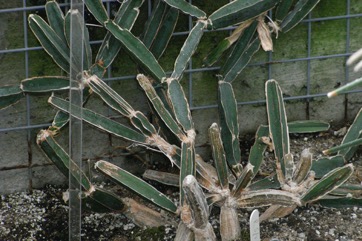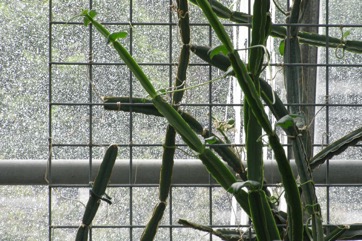Edible stemmed vine

A tropical plant. It occurs in the Ethiopian highlands. The minimum temperature is 15°C. In Thailand it occurs in forests and coastal regions. It grows in the hottest part of India. It grows in hot arid places. It grows between sea level and 1,950 m above sea level. It grows in woodland and savannah. It can grow in arid places. It suits hardiness zones 10-12.
Also known as:
Ali'e, Arugani, Asthisanhara, Athuku bachali, Bohocenou, Chaudhari, Chodhari, Chophi, Choudhari, Daddori, Hadijod, Hadjod, Hadjodi, Hadjora, Haraslata, Harbhanga, Harjora, Harsankari, Harzora, Hasjora, Itachovani, Kaktus manjat, Kan kaw, Kand-vel, Kandra, Karsankari, Kashikafa, Khandvel, Kiritti, Lidzambiso, Mabope, Mafumo, Mangaroli, Mangaroli, Mhais-vel, Murunjurunju, Muvengahonye, Nalleru, Naralai, Nullerootigch, Patah tulang, Perandai keerai, Pirandai, Purundei codie, Renja, Renjam Itachovani, Repich-ingthun, Sam-roi-taw, San chakat, Shazaung-let-set, Sihlonhlwane, Suncaro, Umhlafutu, Vajravalli, Vedhari, Veldt-grape, Winged treebine
Synonyms
- Cissus bifida Schumach. & Thonn.
- Cissus edulis Dalzell
- Cissus quadrangula L.
- Cissus quadrangula Salisb.
- Cissus succulenta (Galpin) Burtt-Davy
- Cissus tetragona Harv.
- Cissus tetraptera Hook.f.
- Cissus triandra Schumach. & Thonn.
- Vitis quadrangularis (L.) Wall. ex Wight & Arn.
- Vitis succulenta Galpin
Edible Portion
- Leaves, Stems, Fruit, Seeds - oil
Where does Edible stemmed vine grow?
Found in: Africa, Angola, Arabia, Asia, Australia, Bangladesh, Benin, Botswana, Burkina Faso, Cambodia, Cameroon, Central Africa, Central African Republic, CAR, Chad, Congo, Côte d'Ivoire, East Africa, Egypt, Eritrea, Eswatini, Ethiopia, Gabon, Gambia, Guinea, Guinée, Guinea-Bissau, Hawaii, India, Indochina, Indonesia, Ivory Coast, Kenya, Laos, Madagascar, Malawi, Malaysia, Maldives, Mali, Mozambique, Myanmar, Namibia, Nigeria, North Africa, Northeastern India, Pacific, Pakistan, Philippines, SE Asia, Senegal, Somalia, South Africa, Southern Africa, Sri Lanka, South Sudan, Sudan, Swaziland, Tanzania, Thailand, Uganda, United States, Vietnam, West Africa, Zambia, Zimbabwe
Notes: It has a number of medicinal uses. There are about 200-350 Cissus species. There are about 75 species in tropical America.
Growing Edible stemmed vine
Cultivation: Plants are easily grown from cuttings of the stem. It can be grown from seed.
Edible Uses: Young leaves and shoots are used in curries. They are also used in the preparation of papadams. Fresh stem pieces are pickled. The stems can be stored for 10 days. The fruit are eaten. The seeds are used for cooking oil. The ash of the plant is used as a substitute for baking powder.
Nutrition Info
per 100g edible portion| Edible Part | Energy (kcal) | Protein (g) | Iron (mg) | Vitamin A (ug) | Vitamin c (mg) | Zinc (mg) | % Water |
|---|---|---|---|---|---|---|---|
| Stems | 37 | 1.2 | 2.1 | - | - | - |
Edible stemmed vine Photos


References
Achigan-Dako, E, et al (Eds), 2009, Catalogue of Traditional Vegetables in Benin. International Foundation for Science.
Ambasta, S.P. (Ed.), 2000, The Useful Plants of India. CSIR India. p 127
Andersohn, G., 1983, Cacti and Succulents. EP Publishing. p 298
Ara, R. I. T., 2015, Leafy Vegetables in Bangladesh. Photon eBooks. p 102
Arinathan, V., et al, 2007, Wild edibles used by Palliyars of the western Ghats, Tamil Nadu. Indian Journal of Traditional Knowledge. 6(1) pp 163-168
Bahru, T., et al, 2013, Wild Edible Plants: Sustainable Use and Management by Indigenous Communities in and the Buffer Area of Awah National Park, Ethiopia. Ethiop. J. Sci., 36(2): 93-108
Baro, D., Baruah, S. and Borthukar, S. K. 2015, Documentation on wild vegetables of Baksa district, BTAD (Assam). Scholars Research Library. Archives of Applied Science Research, 2015, 7 (9):19-2
Bongers, F. et al (Eds), Forest Climbing Plants of West Africa: Diversity, Ecology and Management. CABI
Bonou, A., et al, 2013, Valeur economique des Produits Forestiers Non Ligneux (PFNL) au Benin. Editions Universitaires Europeennes p 92
Brickell, C. (Ed.), 1999, The Royal Horticultural Society A-Z Encyclopedia of Garden Plants. Convent Garden Books. p 270
Burkill, I.H., 1966, A Dictionary of the Economic Products of the Malay Peninsula. Ministry of Agriculture and Cooperatives, Kuala Lumpur, Malaysia. Vol 2 (I-Z) p 2287 (As Vitis quadrangularis)
Chandrakumar, P., et al, 2015, Ethnobotanical studies of wild edible plants of Gond, Halba and Kawar tribes of Salekasa Taluka, Gondia District, Maharashtra State, India. International Research Journal of Pharmacy 6(8)
Chowdery, T., et al, 2014, Wild edible plants of Uttar Dinajpur District, West Bengal. Life Science Leaflets. 47:pp 20-36 http://lifesciencesleaflets.ning.com
Chowdhury, M. & Mukherjee, R., 2012, Wild Edible Plants Consumed by Local Communities of Maldah of West Bengal, India. Indian J.Sci.Res.3(2) : 163-170
Cundall, P., (ed.), 2004, Gardening Australia: flora: the gardener's bible. ABC Books. p 380
Dalziel, J. M., 1937, The Useful plants of west tropical Africa. Crown Agents for the Colonies London.
Dobriyal, M. J. R. & Dobriyal, R., 2014, Non Wood Forest Produce an Option for Ethnic Food and Nutritional Security in India. Int. J. of Usuf. Mngt. 15(1):17-37
Dutta, U., 2012, Wild Vegetables collected by the local communities from the Churang reserve of BTD, Assam. International Journal of Science and Advanced Technology. Vol. 2(4) p 119
Facciola, S., 1998, Cornucopia 2: a Source Book of Edible Plants. Kampong Publications, p 245
FAO, 1988, Traditional Food Plants, FAO Food and Nutrition Paper 42. FAO Rome p 184
Fowler, D. G., 2007, Zambian Plants: Their Vernacular Names and Uses. Kew. p 63
Gallagher, D. E., 2010, Farming beyond the escarpment: Society, Environment, and Mobility in Precolonial Southeastern Burkina Faso. PhD University of Michigan.
Hedrick, U.P., 1919, (Ed.), Sturtevant's edible plants of the world. p 685 (Vitis quandrangularis)
Hossain, U. & Rahman, A., 2018, Study and quantitative analysis of wild vegetable floral diversity available in Barisal district, Bangladesh. Asian J. Med. Biol. Res. 2018, 4 (4), 362-371
Jadhav, R., et al, 2015, Forest Foods of Northern Western Ghats: Mode of Consumption, Nutrition and Availability. Asian Agri-History Vol. 19, No. 4: 293-317
Jardin, C., 1970, List of Foods Used In Africa, FAO Nutrition Information Document Series No 2.p 67, 128
Kar, A., & Borthakur, S. K., 2008, Wild vegetables of Karbi - Anglong district, Assam, Natural Product Radiance, Vol. 7(5), pp 448-460
Karthi, Sathya, & Salome, 2014, Uncultivated Edible Greens from Small Millet Farms Tamil Nadu India. IDRC (As Vitis quadrangularis)
Kumar, R. & Saikia, P., 2020, Wild edible plants of Jharkhand and their utilitarian perspectives. Indian Journal of Traditional Knowledge Vol 19 (2), April 2020, pp 237-250
Kumbhojkar, M.S. & Vartak, V.D., 1988, Ethnobotanical Studies on Wild Edible Grapes from Sacred Groves in Western Maharashtra. J. Econ. Tax. Bot. Vol. 12 No. 2 pp 257-263
Long, C., 2005, Swaziland's Flora - siSwati names and Uses http://www.sntc.org.sz/flora/
Martin, F.W. & Ruberte, R.M., 1979, Edible Leaves of the Tropics. Antillian College Press, Mayaguez, Puerto Rico. p 225
Martin, F.W. & Ruberte, R.M., 1979, Edible Leaves of the Tropics. Antillian College Press, Mayaguez, Puerto Rico. p 174 (As Vitis quadrangularis)
McMakin, P.D., 2000, Flowering Plants of Thailand. A Field Guide. White Lotus. p 63
Miller, A. G., Morris, M. & Stuart-Smith, S., 1988, Plants of Dhofar. The Southern Region of Oman, Traditional, Economic and Medicinal Uses. Sultanate of Oman. p 284
Mohan, V. R. & Kalidass, C., 2010, Nutritional and Antinutritional Evaluation of some Unconventional Wild Edible Plants. Tropical and Subtropical Agroecosystems, 12 (2010): 495- 506
Patiri, B. & Borah, A., 2007, Wild Edible Plants of Assam. Geethaki Publishers. p 27
Peters, C. R., O'Brien, E. M., and Drummond, R.B., 1992, Edible Wild plants of Sub-saharan Africa. Kew. p 201
PROSEA (Plant Resources of South East Asia) handbook, Volume 8, 1993, Vegetables
Ramachandran, V. S., 2007, Wild edible plants of the Anamalais, Coimbatore district, western Ghats, Tamil Nadu. Indian Journal or Traditional Knowledge. 6(1) pp 173-176
Rao, M. L. S., et al, 2014, Indigenous Plant Foods which are commonly consumed by the tribal communities in Dumbriguda Area of Visakhapatnam District, Andhra Pradesh, India. Biolife. Vol 2, Issue 3
Raponda-Walker, A & Sillans, R., 1961, Les Plantes Utiles du Gabon. Editions Paul Lechevalier, Paris. p 55
Rasingam, L., 2012, Ethnobotanical studies on the wild edible plants of Irula tribes of Pillur Valley, Coimbatore district, Tamil Nadu, India. Asian Pacific Journal of Tropical Biomedicine. (2012) S1493-S1497
Royal Botanic Gardens, Kew (1999). Survey of Economic Plants for Arid and Semi-Arid Lands (SEPASAL) database. Published on the Internet; http://www.rbgkew.org.uk/ceb/sepasal/internet [Accessed 13th June 2011]
Samy, J., Sugumaran, M., Lee, K. L. W., 2009, Herbs of Malaysia, Marshall Cavendish. p 80
Sarvalingam, A., et al, 2014, Wild edible plant resources used by the Irulas of the Maruthamalai Hills, Southern Western Ghats, Coimbatore, Tamil Nadu. Indian Journal of Natural Products and Resources 5(2):198-201
Seidemann J., 2005, World Spice Plants. Economic Usage, Botany, Taxonomy. Springer. p 105
Shah, G.L. et al, 1981, An account of the Ethnobotany of Saurashtra in Gujarat State (India). J. Econ. Tax. Bot. Vol 2 pp 173-182
SHORTT,
Singh, H.B., Arora R.K.,1978, Wild edible Plants of India. Indian Council of Agricultural Research, New Delhi. p 21
Staples, G.W. and Herbst, D.R., 2005, A tropical Garden Flora. Bishop Museum Press, Honolulu, Hawaii. p 573
Sujanapal, P., & Sankaran, K. V., 2016, Common Plants of Maldives. FAO & Kerala FRI, p 80
Sukarya, D. G., (Ed.) 2013, 3,500 Plant Species of the Botanic Gardens of Indonesia. LIPI p 911, 989 (Also as Vitis quadrangularis)
Swaziland's Flora Database http://www.sntc.org.sz/flora
Syst. nat. ed. 12, 2:124; Mant. pl. 1:39 ("quadrangulus"). 1767
Tamil herbs, 2007, Edible Plants of the Tropical Dry Evergreen Forest.
Tanaka,
Tredgold, M.H., 1986, Food Plants of Zimbabwe. Mambo Press. p 3
USDA, ARS, National Genetic Resources Program. Germplasm Resources Information Network - (GRIN). [Online Database] National Germplasm Resources Laboratory, Beltsville, Maryland. Available: www.ars-grin.gov/cgi-bin/npgs/html/econ.pl (10 April 2000)
von Katja Rembold, 2011, Conservation status of the vascular plants in East African rain forests. Dissertation Universitat Koblenz-Landau p 160
WATT, (As Vitis quadrangularis)
World Checklist of Useful Plant Species 2020. Royal Botanic Gardens, Kew
www.zimbabweflora.co.zw 2011